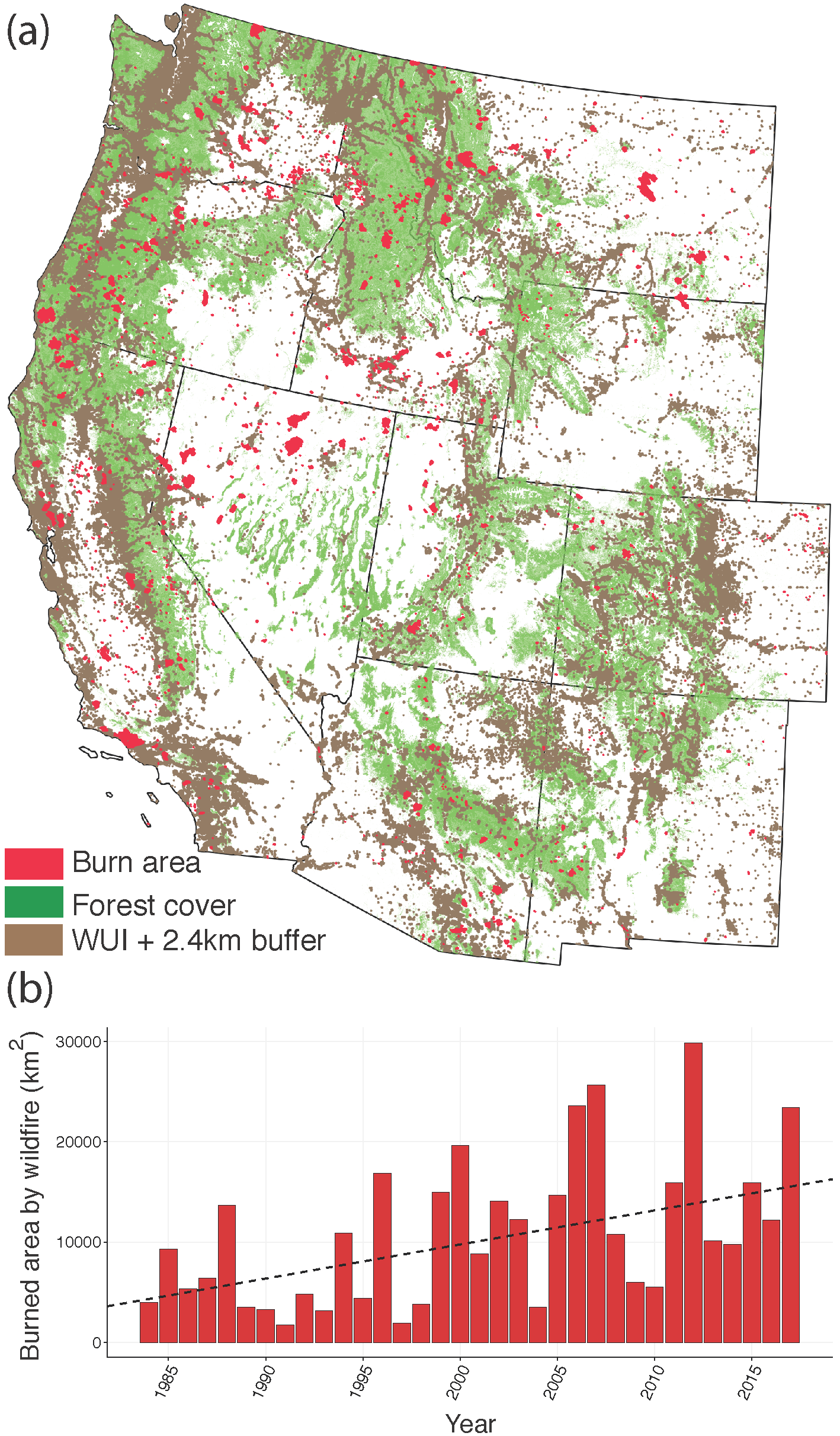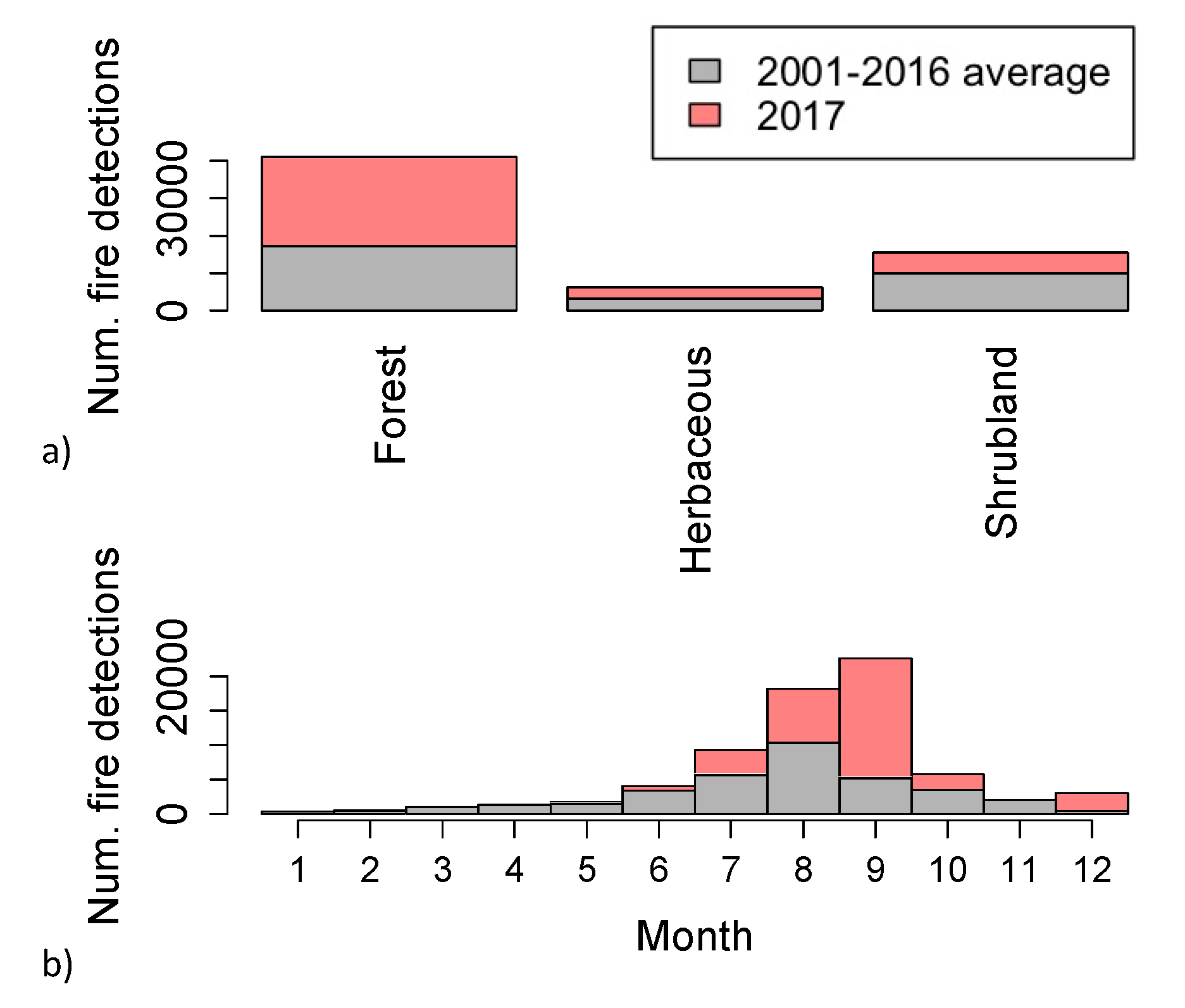Switching on the Big Burn of 2017
Abstract
:1. What Happened during the 2017 Wildfire Season?
2. The Ignition Switch: In 2017, People Started 89% of Wildfires in the U.S.
3. The Fuel Switch: An Extreme Wet Winter and Spring Produced Fine Fuels, Amidst a Historical Legacy of Large Fuels
4. The Aridity Switch: 2017 Had an Extremely Hot and Dry Summer and Fall
5. Anthropogenic Climate Change Likely Made the 2017 Wildfire Season Worse, but Natural Variability Played a Key Role
- Models tend to project a decrease in fall precipitation in California, which may be interpreted as promoting a 2017-like delayed onset of cold-season rains [22], but no clear fall trends have yet emerged in the observed record; and
- There has been no trend in the frequency or intensity of Santa Ana wind events in coastal California since records began in the mid-1900s [23].
6. U.S. Policy Opportunities to Build Better and Burn Better
7. How Do We Better Live in Increasingly Flammable Landscapes?
8. What to Expect in 2018: The Aridity Switch Is already on in Many Parts of the Western U.S.
Author Contributions
Acknowledgments
Conflicts of Interest
Data and Materials Availability
References
- National Interagency Fire Center. Total Wildland Fires and Acres (1960–2017); National Interagency Fire Center: Boise, ID, USA, 2017.
- Climate Central. Western Wildfires Undermining Progress on Air Pollution. Available online: http://www.climatecentral.org/news/report-wildfires-undermining-air-pollution-progress-21753 (accessed on 26 May 2018).
- Miller, C.; Irfan, U. Map: See where wildfires are causing record pollution in California. Vox, 12 September 2017. [Google Scholar]
- Bradstock, R.A. A biogeographic model of fire regimes in Australia: Current and future implications. Glob. Ecol. Biogeogr. 2010, 19, 145–158. [Google Scholar] [CrossRef]
- Giglio, L.; Loboda, T.; Roy, D.P.; Quayle, B.; Justice, C.O. An active-fire based burned area mapping algorithm for the MODIS sensor. Remote Sens. Environ. 2009, 113, 408–420. [Google Scholar] [CrossRef]
- Eidenshink, J.; Schwind, B.; Brewer, K.; Zhu, Z.L.; Quayle, B.; Howard, S. A project for monitoring trends in burn severity. Fire Ecol. 2007, 3, 3–21. [Google Scholar] [CrossRef]
- Balch, J.K.; Bradley, B.A.; Abatzoglou, J.T.; Nagy, R.C.; Fusco, E.J.; Mahood, A.L. Human-started wildfires expand the fire niche across the United States. Proc. Natl. Acad. Sci. USA 2017, 114, 2946–2951. [Google Scholar] [CrossRef] [PubMed]
- Balch, J.K.; Bradley, B.A.; D’Antonio, C.M.; Gomez-Dans, J. Introduced annual grass increases regional fire activity across the arid western USA (1980–2009). Glob. Chang. Biol. 2013, 19, 173–183. [Google Scholar] [CrossRef] [PubMed]
- Giglio, L.; Csiszar, I.; Justice, C.O. Global distribution and seasonality of active fires as observed with the Terra and Aqua Moderate Resolution Imaging Spectroradiometer (MODIS) sensors. J. Geophys. Res. Biogeosci. 2006, 111. [Google Scholar] [CrossRef] [Green Version]
- Schoennagel, T.; Veblen, T.T.; Romme, W.H. The interaction of fire, fuels, and climate across rocky mountain forests. Bioscience 2004, 54, 661–676. [Google Scholar] [CrossRef]
- Radeloff, V.C.; Helmers, D.P.; Kramer, H.A.; Mockrin, M.H.; Alexandre, P.M.; Bar-Massada, A.; Butsic, V.; Hawbaker, T.J.; Martinuzzi, S.; Syphard, A.D.; et al. Rapid growth of the US wildland-urban interface raises wildfire risk. Proc. Natl. Acad. Sci. USA 2018, 115, 3314–3319. [Google Scholar] [CrossRef] [PubMed]
- Hjerpe, E.; Kim, Y.-S.; Dunn, L. Forest density preferences of homebuyers in the wildland-urban interface. For. Policy Econ. 2016, 70, 56–66. [Google Scholar] [CrossRef]
- Vose, R.S.; Applequist, S.; Squires, M.; Durre, I.; Menne, M.J.; Williams, C.N., Jr.; Fenimore, C.; Gleason, K.; Arndt, D. Improved historical temperature and precipitation time series for US climate divisions. J. Appl. Meteorol. Climatol. 2014, 53, 1232–1251. [Google Scholar] [CrossRef]
- Mote, P.W.; Li, S.; Lettenmaier, D.P.; Xiao, M.; Engel, R. Dramatic declines in snowpack in the western US. npj Clim. Atmos. Sci. 2018, 1, 2. [Google Scholar] [CrossRef]
- Westerling, A.L. Increasing western US forest wildfire activity: Sensitivity to changes in the timing of spring. Philos. Trans. R. Soc. Lond. B Biol. Sci. 2016, 371, 20150178. [Google Scholar] [CrossRef] [PubMed]
- Dennison, P.E.; Brewer, S.C.; Arnold, J.D.; Moritz, M.A. Large wildfire trends in the western United States, 1984–2011. Geophys. Res. Lett. 2014, 41, 2928–2933. [Google Scholar] [CrossRef]
- Abatzoglou, J.T.; Williams, A.P. Impact of anthropogenic climate change on wildfire across western US forests. Proc. Natl. Acad. Sci. USA 2016, 113, 11770–11775. [Google Scholar] [CrossRef] [PubMed] [Green Version]
- Berg, N.; Hall, A. Increased interannual precipitation extremes over California under climate change. J. Clim. 2015, 28, 6324–6334. [Google Scholar] [CrossRef]
- Swain, D.L.; Langenbrunner, B.; Neelin, J.D.; Hall, A. Increasing precipitation volatility in twenty-first-century California. Nat. Clim. Chang. 2018, 8, 427–433. [Google Scholar] [CrossRef]
- Seager, R.; Neelin, D.; Simpson, I.; Liu, H.; Henderson, N.; Shaw, T.; Kushnir, Y.; Ting, M.; Cook, B. Dynamical and Thermodynamical Causes of Large-Scale Changes in the Hydrological Cycle over North America in Response to Global Warming. J. Clim. 2014, 27, 7921–7948. [Google Scholar] [CrossRef]
- Abatzoglou, J.T.; Rupp, D.E.; Mote, P.W. Seasonal Climate Variability and Change in the Pacific Northwest of the United States. J. Clim. 2014, 27, 2125–2142. [Google Scholar] [CrossRef] [Green Version]
- Melillo, J.M.; Richmond, T.; Yohe, G.W. Climate Change Impacts in the United States: The Third National Climate Assessment; U.S. Global Change Research Program: Washington, DC, USA, 2014; p. 841.
- Abatzoglou, J.T.; Kolden, C.A. Relationships between climate and macroscale area burned in the western United States. Int. J. Wildland Fire 2013, 22, 1003–1020. [Google Scholar] [CrossRef]
- Diffenbaugh, N.S.; Singh, D.; Mankin, J.S.; Horton, D.E.; Swain, D.L.; Touma, D.; Charland, A.; Liu, Y.; Haugen, M.; Tsiang, M.; et al. Quantifying the influence of global warming on unprecedented extreme climate events. Proc. Natl. Acad. Sci. USA 2017, 114, 4881–4886. [Google Scholar] [CrossRef] [PubMed] [Green Version]
- Schoennagel, T.; Balch, J.K.; Brenkert-Smith, H.; Dennison, P.E.; Harvey, B.J.; Krawchuk, M.A.; Mietkiewicz, N.; Morgan, P.; Moritz, M.A.; Rasker, R.; et al. Adapt to more wildfire in western North American forests as climate changes. Proc. Natl. Acad. Sci. USA 2017, 114, 4582–4590. [Google Scholar] [CrossRef] [PubMed]
- Multihazard Mitigation Council. Natural Hazard Mitigation Saves: 2017 Interim Report; National Institute of Building Sciences: Washington, DC, USA, 2017. [Google Scholar]
- Botts, H.; Jeffery, T.; Lindfors, Z. CoreLogic Wildfire Hazard Risk Report; CoreLogic: Irvine, CA, USA, 2016; Available online: http://arcg.is/0iGDSD (accessed on 26 May 2018).
- Headwaters Economics. The Full Community Costs of Wildfire; Headwaters Economics: Bozeman, MT, USA, 2018; p. 44. [Google Scholar]
- Moritz, M.A.; Batllori, E.; Bradstock, R.A.; Gill, A.M.; Handmer, J.; Hessburg, P.F.; Leonard, J.; McCaffrey, S.; Odion, D.C.; Schoennagel, T.; et al. Learning to coexist with wildfire. Nature 2014, 515, 58–66. [Google Scholar] [CrossRef] [PubMed]
- Toman, E.; Stidham, M.; McCaffrey, S.; Shindler, B. Social Science at the Wildland-Urban Interface: A Compendium of Research Results to Create Fire-Adapted Communities; General Technical Report NRS NRS-GTR-111; U.S. Department of Agriculture, Forest Service, Northern Research Station: Newton Square, PA, USA, 2013; p. 75.
- Calkin, D.E.; Cohen, J.D.; Finney, M.A.; Thompson, M.P. How risk management can prevent future wildfire disasters in the wildland-urban interface. Proc. Natl. Acad. Sci. USA 2014, 111, 746–751. [Google Scholar] [CrossRef] [PubMed]
- Smith, A.M.; Kolden, C.A.; Paveglio, T.B.; Cochrane, M.A.; Bowman, D.M.; Moritz, M.A.; Kliskey, A.D.; Alessa, L.; Hudak, A.T.; Hoffman, C.M.; et al. The science of firescapes: Achieving fire-resilient communities. Bioscience 2016, 66, 130–146. [Google Scholar] [CrossRef] [PubMed]
- Williams, A.P.; Schwartz, R.E.; Iacobellis, S.; Seager, R.; Cook, B.I.; Still, C.J.; Husak, G.; Michaelsen, J. Urbanization causes increased cloud-base height and decreased fog in coastal southern California. Geophys. Res. Lett. 2015, 42, 1527–1536. [Google Scholar] [CrossRef]
- Williams, A.P.; Gentine, P.; Moritz, M.A.; Roberts, D.A.; Abatzoglou, J.T. Effect of reduced summer cloud shading on evaporative demand and wildfire in coastal southern California. Geophys. Res. Lett. 2018, in press. [Google Scholar] [CrossRef]
- Barnett, K.; Parks, S.A.; Miller, C.; Naughton, H.T. Beyond fuel treatment effectiveness: Characterizing Interactions between fire and treatments in the US. Forests 2016, 7, 237. [Google Scholar] [CrossRef]
- Ryan, K.C.; Knapp, E.E.; Varner, J.M. Prescribed fire in North American forests and woodlands: History, current practice, and challenges. Front. Ecol. Environ. 2013, 11, e15–e24. [Google Scholar] [CrossRef]
- National Interagency Fire Center (NIFC). National Significant Wildland Fire—Potential Outlook; Issued 1 May 2018; NIFC: Boise, ID, USA, 2018.



© 2018 by the authors. Licensee MDPI, Basel, Switzerland. This article is an open access article distributed under the terms and conditions of the Creative Commons Attribution (CC BY) license (http://creativecommons.org/licenses/by/4.0/).
Share and Cite
Balch, J.K.; Schoennagel, T.; Williams, A.P.; Abatzoglou, J.T.; Cattau, M.E.; Mietkiewicz, N.P.; St. Denis, L.A. Switching on the Big Burn of 2017. Fire 2018, 1, 17. https://doi.org/10.3390/fire1010017
Balch JK, Schoennagel T, Williams AP, Abatzoglou JT, Cattau ME, Mietkiewicz NP, St. Denis LA. Switching on the Big Burn of 2017. Fire. 2018; 1(1):17. https://doi.org/10.3390/fire1010017
Chicago/Turabian StyleBalch, Jennifer K., Tania Schoennagel, A. Park Williams, John T. Abatzoglou, Megan E. Cattau, Nathan P. Mietkiewicz, and Lise A. St. Denis. 2018. "Switching on the Big Burn of 2017" Fire 1, no. 1: 17. https://doi.org/10.3390/fire1010017




